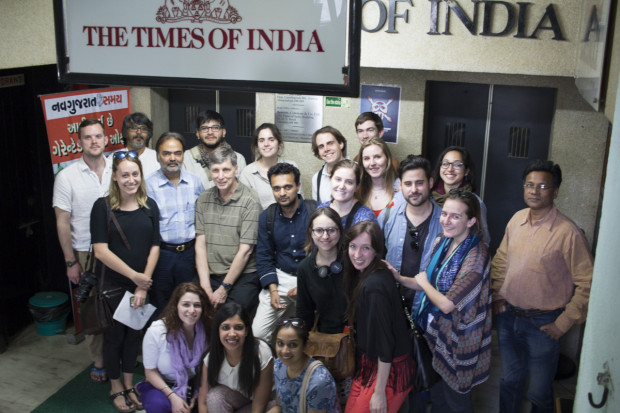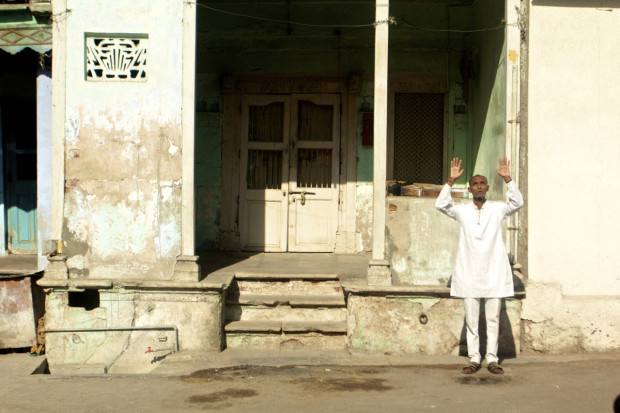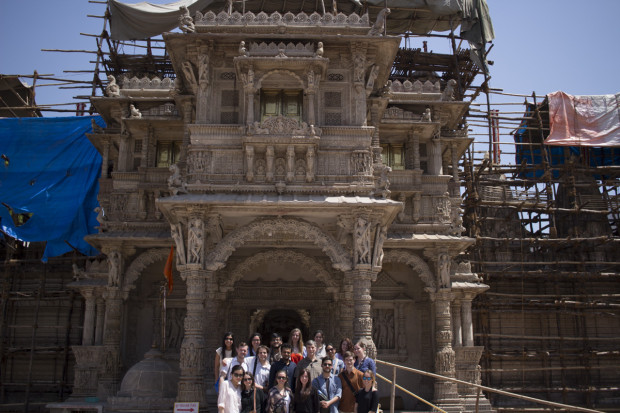AHMEDABAD – After a week of touring religious sites in the north of India, meeting spiritual leaders along the way, we focused today on how best to tell the religion story as journalists. At the Ahmedabad offices of the Times of India, we sat down with several reporters and editors who have extensively covered religion in India.
Throughout the trip, our reporters’ minds have been whirring with questions introduced during our “Covering Religion” seminar. How does one write about religion without emphasizing conflict? How does one avoid focusing upon the stereotypical over the nuanced? How does one balance writing about the religious majority in relation to religious minorities? And, finally, does the public still have an appetite for journalism on religion?
Among the journalists we spoke with were Pradeep Mallik of the Ahmedabad Mirror and Ajay Umat of Navgujarat Samay, two newspapers of the Times of India Group. Both highlighted that unlike American and Western European newspapers, which have suffered great circulation losses as readers have migrated to digital platforms, print was still a significant force in Indian life. The Times of India sold 6.7 million copies a day in 42 regional editions in English alone, making it the largest selling English daily newspaper in the world.
Religion was an important part of Indian journalism, they said, with most papers having sections or reporters dedicated to the beat. The topic is particularly prominent in ethnic language newspapers that still abound in India. As news begins to move across to digital platforms, this discussion of religion will gain an even greater reach across the country – in both English and language papers.
“Language newspapers will guarantee a readership for another generation even as English language papers die,” Umat said.
Our discussion at the Times of India offices came after a day of exploring Ahmedabad’s historic and religiously diverse Old City. Our guide for the tour was the seemingly omniscient Girish Gupta whose knowledge of the city was encyclopedic. What was most apparent throughout the day was the inextricable link between religion and the city itself. Indeed, as Gupta pointed out, in “every inch there is something pure or religious available.”
As we made our way through the narrow alleys of Ahmedabad’s pols – or residential areas – Gupta pointed out the chilies and mango leaves that hung from wooden door frames to maintain a household’s spiritual purity. While dogs lay languidly in the heat, a man stood pouring water from a small ceramic bowl into the street. With his face raised towards the sky and eyes closed, he ushered in the day by offering prayers to God. Many walls were peppered with tiles depicting divine figures, or crevices shielding small, glittering shrines.
In the heart of a predominantly Jain pol, it seemed almost impossible to turn a corner without stumbling upon a Jain shrine or temple. One particularly welcoming priest, adorned in bright white robes, drew back the curtain of a small shrine to reveal the bulging eyes of a black marble murti within. Even Ahmedabad’s variety of architecture displayed religious complexity. At a larger Jain temple, before walking through the ornate archways, complete with demons sculpted at the base to guard the temple, we were greeted by a pair of domes reminiscent of Islamic architecture. Although they were for a practical purpose – designed to allow worshipers with arthritis to look down and see a reflection of the murti in the basement below – it epitomized the religious pluralism here in Ahmedabad.
This amalgamation of differing religions was easily explained with a visit to the Parsi Fire Temple and Magen Abraham Synagogue, conveniently located on either side of the same road in the Old City.
Notoriously closed off, those outside of the Parsi or Zoroastrian faith are unable to enter the temple itself, so the only insight provided was through the descriptions and narrative of the Parsi guide, who gave his name as Firoz. The mysterious references to an inner chamber where a flame, or chingari–a spark of divine power–is venerated by Parsi worshipers, left a lot to the imagination.
There are about 600 Parsi families in Ahmedabad, Firoz told us. He said that the Parsi community does not face any religious prejudice, a sentiment echoed by his Jewish counterpart in the synagogue across the road. There are about 300 Jews in Ahmedabad the Jewish guide, Menasseh Solomon, told us. These micro-minorities are largely left alone even as tensions arise between the dominant Hindu culture and larger minorities like Christians and Muslims.
The Parsi and Jewish guides said that while they do not fear discrimination, there is a shadow hanging over both faiths. Both religious spokesmen agreed that there is a tinge of fear that their religions may eventually fade out or become extinct in the city, or at least that their current form may disappear. As the Parsi community does not accept converts, and their international population is sparse at best, there is no certainty that their beliefs and traditions will live on.
Equally, the Jewish congregation in Ahmedabad continues to use Indian last names rather than Jewish, and will not allow conversions unless it is for the purpose marriage. With more Indian Jews migrating to countries such as Israel, Solomon admitted there may come a time when there are only a handful of Jewish families left in Ahmedabad to attend services.
Our final religious site of the day was a Jain Temple known as Hathi Sinha Deri. Grandiose and beautifully carved, the temple provided the perfect place to reflect upon these questions of religious diversity. Despite a crew of hammering construction workers restoring the temple through an arduous cleaning process as to not ruin the sandstone, the sheer beauty of the temple and the hypnotizing candlelit murtis within were enough to calm our spirits after a long day of exploring the religiously complex city of Ahmedabad.


